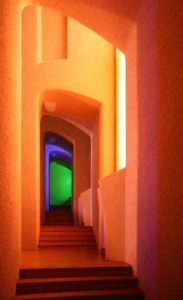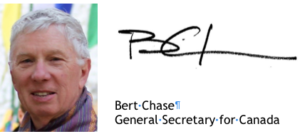26 Apr From the World Society On A Culture of Agreement
 Dear Members and Friends of the Anthroposophical Society in Canada,
Dear Members and Friends of the Anthroposophical Society in Canada,
Beginnings…
Witnessing the miracle of development that takes place with the newborn infant reaches deeply into our being, touching the essence of our own humanity. We cannot help but marvel at the extraordinary processes of adaptation that the child goes through in order to form a relationship with its fundamentally transformed reality. The process is lengthy, extending far beyond the initial months into years of maturation. Yet, at its core, all of the stages of growth arise out of the deepest inner longing rising from the spiritual core of the incarnating individuality to enter into a true relationship with its new reality.
We can have a sense for the immensity of this impulse when we consider how fundamentally different every aspect of its pre-birth existence is. We need only reflect on life suspended in a liquid universe to have a sense for the complete transformation that occurs at birth’s threshold. Processes of sustenance, all the bodily functions, sensory activities, all take place within the context of this ‘water world’. Inwardly, following these days before birth and then trying to imagine the threshold processes leading into a completely new reality, draws us close to the heart of becoming a true human being.
Though monumental, archetypal in its nature, this mighty transition from one state of being into another is central to human evolution. We are continuously going through thresholds, leaving behind states of existence that have served their purpose, and moving into new conditions of existence. These transitions are inevitably unconscious unless they create pain or suffering. We dream through these critical points of transformation and in our dreaming lose the possibility for consciously connecting with these ‘miracle points’ on our human journey.
Just as our individual journeys go through these thresholding processes, so too does humanity as a whole. Rudolf Steiner makes clear that humanity is in such a fundamental threshold toward the beginning of a fundamentally new reality. In many ways he reveals how deep the transformation must be for us to move through this new birth. The larger context for this transition is that we are at the beginning of a new age in our human journey. The previous age, the Age of Darkness, has ended. We know this as a thought, but it is far more challenging to allow the thought to become experience. How do we begin the process, or assist in the process, of encouraging each other to awaken to the steps we must take as individuals and as communities to become active in this monumental cultural transformation?
We can put this into context when we consider that in the long stream of human development this is only the fourth time that a transition of such magnitude has occurred. This is truly a ‘turning point in time’. We can approach the immensity of this reality first as a concept, but for it to become an active living process requires consciousness and attention. We are called as students of Rudolf Steiner to become active participants in this process. How do we do this? What can guide us in this task?
Each autumn, as the Dornach hills are washed in the soft gray light of an approaching winter, a unique organ of our anthroposophical life gathers at the Goetheanum. Meeting in the Schreinerei, Class holders from around the world gather where Rudolf Steiner gave birth to an earthly form for the cosmic Michael School – the School of Spiritual Science. Over many years, the question of how we live the reality of entering a new age has formed the framework for these conclaves. How can we observe the fruits, but also the hindrances, of the age that lies behind us in such a way that we can begin to make active a life in anthroposophy that orients itself to what needs to arise in the future?
As we consider the gifts and challenges of the Age of Darkness what confronts us is the tension that has been developed between the individual and the community. We might say that at the heart of Kali Yuga is the becoming of the ‘free individual’ – the individual no longer defined by its community. But this ‘free individual’ only has meaning in relationship to a new, freely chosen, community. Recognizing this reality is, for many of our contemporaries, for many of us in the anthroposophical movement, extremely uncomfortable. This discomfort, even pain, arises out of the long struggle, an age-long struggle, to stand in individual dignity. Yet this place of freedom quickly becomes isolation, alienation, and is of no value unless we freely choose to cultivate the faculties needed for this new age, this newly arising reality.
One way of creating an orientation to this movement from individual to community in a healthy, in a healing way is to consider the fundamental structures of our communities. Looking back over the age leading to the emergence of the free individual, we can recognize that all of the structures that we have inherited out of this past age focus on the ‘rights’ of the emerging individual. The leading cultural question has been, ‘How does the community benefit me?’ This self-centred focus was necessary in order to protect the developing individual. Now we must ask whether this orientation has become a fundamental hindrance to the needed transformation of human culture.
One way of framing this question that the international Circle of Classholders has taken up in different ways is to conscientiously work toward the development of a Culture of Agreement. For this to even be conceptualized requires a profound shift in our relationship as individuals to our chosen community, our anthroposophical community. What does it mean on the level of fundamental experience to move from a culture whose focus is on the privileges of the individual to a community of free individuals based on agreement?
For this to even begin to be possible requires each of us to shift our self-perception, the construct of our self-perception, inherited from a past reality.
Rudolf Steiner modeled this process in many ways. For visual artists one of the most potent embodiments of this transformed relationship between individual and community is given to us by the relationship cultivated between Rudolf Steiner and Edith Maryon, the first leader of the Visual Arts Section. The essence of this transformation is powerfully distilled in the threefold formula that Rudolf Steiner gave to Edith Maryon as the foundation for cultivating a future oriented relationship between individual and community.
Most striking in this formulation is its beginning. To go through this threshold, humanity must recognize that we are in a process whose outcome is not yet clear. That there is much that is woven into our interrelationships from the past that leads away from wholeness, away from health. To walk this path of transforming, both communities and individuals must see that we are in a condition that is fractured, that healing is necessary – and that this healing process is conditional, it is not a given.
What is most striking is that the first step in this healing process is completely dependent upon a significant shift in how we, as now ‘free individuals’, cultivate our own soul life. Our accustomed, our inherited orientation has been to see our own soul life at the centre of our individual universes. In order for healing to occur we are called upon to practice a fundamental shift in our inner lives. We are called upon to make of our souls a completely still receptive vessel, a mirror, that can – without distortion – allow the essence of the community to be formed in our inner experience. We are called upon not to project into our world what we would want, out of our soul experience, to be reflected in our human environment, but instead to allow the essence, the deep inner nature of those around us to have a home in our still receptive inner lives.
It is only when each member of the community is able to create this receptive stillness in their own souls that the community can then discern; not what the individual feels their gifts are, what the individual thinks they should contribute to the community, but what lies as a unique capacity of the individual that can contribute to healing, to make whole the community.
It is then that we can begin to walk from a community based on individual rights to a community based on a Culture of Agreement.
Healing is, only when
In the mirror of the Human Soul
the whole community takes on form
And when, in the Community
Lives the Strength of the individual soul
With warm regards,
